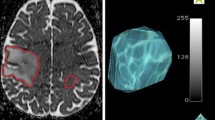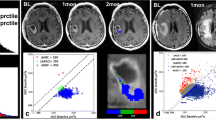Abstract
Purpose: To investigate the association of pre-radiotherapy apparent diffusion coefficient (ADC) abnormalities with patterns of recurrence and outcomes in patients with glioblastoma multiforme (GBM). Materials and Methods: Fifty-two patients with recurrent GBM were retrospectively evaluated. Diffusion MRI images were acquired for all patients postoperatively prior to radiotherapy. ADC images were evaluated for geographic regions of diffusion restriction (hypointensity) within the FLAIR volume. If identified, the ADC map and the T1+C MRI at the time of recurrence were registered to the original plan to determine the pattern of recurrence and the coverage of the ADC abnormality by the 60 Gy isodose line (IDL). Progression-free and overall survival was determined for patients with and without an ADC hypointensity. Results: An ADC hypointensity was identified in 32 (62 %) of cases. The recurrence pattern in these cases was central in 27/32 (84 %), marginal in 4/32 (13 %) and distant in 1/32 (3 %). The recurrence overlapped with the ADC hypointensity in 28 (88 %) patients. The ADC hypointensity was covered by 95 % of the 60 Gy IDL in all cases. Kaplan–Meier analysis revealed inferior progression free survival and overall survival in patients with an ADC hypointensity compared to those without, despite similarities between the groups in terms of age, RT dose, performance status, and extent of resection. Conclusions: The presence of an ADC hypointensity on pre-radiotherapy diffusion-weighted imaging is associated with the location of tumor recurrence as demonstrated by frequent overlap in this series, and is associated with a trend toward inferior outcomes. This abnormality may reflect a high risk region of hypercellularity and warrants consideration with respect to radiotherapy planning.


Similar content being viewed by others
References
DeAngelis LM (2001) Brain tumors. N Engl J Med 344(2):114–123
Stupp R, Mason WP, van den Bent MJ et al (2005) Radiotherapy plus concomitant and adjuvant temozolomide for glioblastoma. N Engl J Med 352(10):987–996
Stupp R, Hegi ME, Mason WP et al (2009) Effects of radiotherapy with concomitant and adjuvant temozolomide versus radiotherapy alone on survival in glioblastoma in a randomised phase III study: 5-year analysis of the EORTC-NCIC trial. Lancet Oncol 10(5):459–466
Kelly PJ, Daumas-Duport C, Kispert DB, Kall BA, Scheithauer BW, Illig JJ (1987) Imaging-based stereotaxic serial biopsies in untreated intracranial glial neoplasms. J Neurosurg 66(6):865–874
Mori S, Barker PB (1999) Diffusion magnetic resonance imaging: its principle and applications. Anat Rec 257(3):102–109
Hagmann P, Jonasson L, Maeder P, Thiran JP, Wedeen VJ, Meuli R (2006) Understanding diffusion MR imaging techniques: from scalar diffusion-weighted imaging to diffusion tensor imaging and beyond. Radiographics 26(Suppl 1):S205–S223
Karaarslan E, Arslan A (2008) Diffusion weighted MR imaging in non-infarct lesions of the brain. Eur J Radiol 65(3):402–416
Ellingson BM, Malkin MG, Rand SD et al (2010) Validation of functional diffusion maps (fDMs) as a biomarker for human glioma cellularity. J Magn Reson Imaging 31(3):538–548
Sugahara T, Korogi Y, Kochi M et al (1999) Usefulness of diffusion-weighted MRI with echo-planar technique in the evaluation of cellularity in gliomas. J Magn Reson Imaging 9(1):53–60
Guo AC, Cummings TJ, Dash RC, Provenzale JM (2002) Lymphomas and high-grade astrocytomas: comparison of water diffusibility and histologic characteristics. Radiology 224(1):177–183
Li Y, Lupo JM, Polley MY et al (2011) Serial analysis of imaging parameters in patients with newly diagnosed glioblastoma multiforme. Neuro Oncol 13(5):546–557
Lutz K, Wiestler B, Graf M (2013) Infiltrative patterns of glioblastoma: identification of tumor progress using apparent diffusion coefficient histograms. J Magn Reson Imaging 39(5):1096–1103
Moffat BA, Chenevert TL, Lawrence TS et al (2005) Functional diffusion map: a noninvasive MRI biomarker for early stratification of clinical brain tumor response. Proc Natl Acad Sci USA 102(15):5524–5529
Ellingson BM, Cloughesy TF, Lai A et al (2011) Graded functional diffusion map-defined characteristics of apparent diffusion coefficients predict overall survival in recurrent glioblastoma treated with bevacizumab. Neuro Oncol 13(10):1151–1161
Pope WB, Lai A, Mehta R et al (2011) Apparent diffusion coefficient histogram analysis stratifies progression-free survival in newly diagnosed bevacizumab-treated glioblastoma. Am J Neuroradiol 32(5):882–889
Pope WB, Qiao XJ, Kim HJ et al (2012) Apparent diffusion coefficient histogram analysis stratifies progression-free and overall survival in patients with recurrent GBM treated with bevacizumab: a multi-center study. J Neuro Oncol 108(3):491–498
Paldino MJ, Desjardins A, Friedman HS, Vredenburgh JJ, Barboriak DP (2012) A change in the apparent diffusion coefficient after treatment with bevacizumab is associated with decreased survival in patients with recurrent glioblastoma multiforme. Br J Radiol 85(1012):382–389
Ellingson BM, Cloughesy TF, Lai A, Nghiemphu PL, Pope WB (2012) Nonlinear registration of diffusion-weighted images improves clinical sensitivity of functional diffusion maps in recurrent glioblastoma treated with bevacizumab. Magn Reson Med 67(1):237–245
Gupta A, Young RJ, Karimi S et al (2011) Isolated diffusion restriction precedes the development of enhancing tumor in a subset of patients with glioblastoma. Am J Neuroradiol 32(7):1301–1306
Paulson ES, Erickson B, Schultz C, Li XA (2014) Comprehensive MRI simulation methodology using a dedicated MRI scanner in radiation oncology for external beam radiation treatment planning. Med Phys 42:28–39
Provenzale JM, Engelter ST, Petrella JR, Smith JS, MacFall JR (1999) Use of MR exponential diffusion-weighted images to eradicate T2 “shine-through” effect. Am J Roentgenol 172(2):537–539
Schaefer PW, Grant PE, Gonzalez RG (2000) Diffusion-weighted MR imaging of the brain. Radiology 217(2):331–345
Brandes AA, Tosoni A, Franceschi E et al (2009) Recurrence pattern after temozolomide concomitant with and adjuvant to radiotherapy in newly diagnosed patients with glioblastoma: correlation with MGMT promoter methylation status. J Clin Oncol 27(8):1275–1279
Dobelbower MC, Burnett Iii OL, Nordal RA et al (2011) Patterns of failure for glioblastoma multiforme following concurrent radiation and temozolomide. J Med Imaging Radiat Oncol 55(1):77–81
McDonald MW, Shu HK, Curran WJ Jr, Crocker IR (2011) Pattern of failure after limited margin radiotherapy and temozolomide for glioblastoma. Int J Radiat Oncol Biol Phys 79(1):130–136
Milano MT, Okunieff P, Donatello RS et al (2010) Patterns and timing of recurrence after temozolomide-based chemoradiation for glioblastoma. Int J Radiat Oncol Biol Phys 78(4):1147–1155
Minniti G, Amelio D, Amichetti M et al (2010) Patterns of failure and comparison of different target volume delineations in patients with glioblastoma treated with conformal radiotherapy plus concomitant and adjuvant temozolomide. Radiother Oncol 97(3):377–381
Ogura K, Mizowaki T, Arakawa Y (2013) Initial and cumulative recurrence patterns of glioblastoma after temozolomide-based chemoradiotherapy and salvage treatment: a retrospective cohort study in a single institution. Radiat Oncol 8:97
Buatti JM, Friedman WA, Bova FJ, Mendenhall WM (1995) Linac radiosurgery for high-grade gliomas: the university of florida experience. Int J Radiat Oncol Biol Phys 32(1):205–210
Gannett D, Stea B, Lulu B, Adair T, Verdi C, Hamilton A (1995) Stereotactic radiosurgery as an adjunct to surgery and external beam radiotherapy in the treatment of patients with malignant gliomas. Int J Radiat Oncol Biol Phys 33(2):461–468
Shrieve DC, Alexander E 3rd, Black PM et al (1999) Treatment of patients with primary glioblastoma multiforme with standard postoperative radiotherapy and radiosurgical boost: prognostic factors and long-term outcome. J Neurosurg 90(1):72–77
Cardinale R, Won M, Choucair A et al (2006) A phase II trial of accelerated radiotherapy using weekly stereotactic conformal boost for supratentorial glioblastoma multiforme: RTOG 0023. Int J Radiat Oncol Biol Phys 65(5):1422–1428
Chan JL, Lee SW, Fraass BA et al (2002) Survival and failure patterns of high-grade gliomas after three-dimensional conformal radiotherapy. J Clin Oncol 20(6):1635–1642
Souhami L, Seiferheld W, Brachman D et al (2004) Randomized comparison of stereotactic radiosurgery followed by conventional radiotherapy with carmustine to conventional radiotherapy with carmustine for patients with glioblastoma multiforme: report of radiation therapy oncology group 93-05 protocol. Int J Radiat Oncol Biol Phys 60(3):853–860
Tsao MN, Mehta MP, Whelan TJ et al (2005) The american society for therapeutic radiology and oncology (ASTRO) evidence-based review of the role of radiosurgery for malignant glioma. Int J Radiat Oncol Biol Phys 63(1):47–55
Park I, Tamai G, Lee MC et al (2007) Patterns of recurrence analysis in newly diagnosed glioblastoma multiforme after three-dimensional conformal radiation therapy with respect to pre-radiation therapy magnetic resonance spectroscopic findings. Int J Radiat Oncol Biol Phys 69(2):381–389
Tsien CI, Brown D, Normolle D et al (2012) Concurrent temozolomide and dose-escalated intensity modulated radiation therapy in newly diagnosed glioblastoma. Clin Cancer Res 18(1):273–279
Lee IH, Piert M, Gomez-Hassan D et al (2009) Association of 11C-methionine PET uptake with site of failure after concurrent temozolomide and radiation for primary glioblastoma multiforme. Int J Radiat Oncol Biol Phys 73(2):479–485
Chang EL, Akyurek S, Avalos T et al (2007) Evaluation of peritumoral edema in the delineation of radiotherapy clinical target volumes for glioblastoma. Int J Radiat Oncol Biol Phys 68(1):144–150
Lee SW, Fraass BA, Marsh LH et al (1999) Patterns of failure following high-dose 3-D conformal radiotherapy for high-grade astrocytomas: a quantitative dosimetric study. Int J Radiat Oncol Biol Phys 43(1):79–88
Hegi ME, Diserens AC, Gorlia T et al (2005) MGMT gene silencing and benefit from temozolomide in glioblastoma. N Engl J Med 352(10):997–1003
Conflict of interest
The authors declare that they have no conflict of interest. The authors have no financial disclosures with regard to this work.
Author information
Authors and Affiliations
Corresponding author
Rights and permissions
About this article
Cite this article
Elson, A., Paulson, E., Bovi, J. et al. Evaluation of pre-radiotherapy apparent diffusion coefficient (ADC): patterns of recurrence and survival outcomes analysis in patients treated for glioblastoma multiforme. J Neurooncol 123, 179–188 (2015). https://doi.org/10.1007/s11060-015-1782-5
Received:
Accepted:
Published:
Issue Date:
DOI: https://doi.org/10.1007/s11060-015-1782-5




